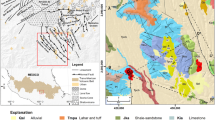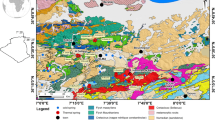Abstract
The west coast geothermal province in Maharashtra hosts a number of thermal springs along the 350 km linear stretch. Major and trace element analyses of thermal springs from 15 locations along with groundwater and surface water samples have been studied. The thermal waters had temperatures ranging from 40 to 71 °C, pH from 7.1 to 8.8 and total dissolved solids between 337 and 8698 mg/l. Most of the thermal waters are Na-Ca-Cl or Ca-Na-Cl type except one which is of Na-HCO3 type. The major ion data is comparable over three decades suggesting a mature geothermal system in the west coast. Trace elements concentrations were low in case of some elements such as<0.1 ppb of Ag and Cd, 1–3 ppb of Cr, Zn, Co, Cu, Pb and Ni, whereas elements like Li (19–386 ppb), B (104–1362 ppb), Sr (16–13,560 ppb), Rb (13–220 ppb), Cs (0.75–44 ppb) and Ba (3–2077 ppb) were much higher in concentration. The variations in the trace element concentration in the thermal waters indicate involvement of different rock types although all the thermal emergences are within the Deccan volcanic flows.










Similar content being viewed by others
References
Abdillahi Elmi S (2009) Gallium and germanium distribution in geothermal water. Geothermal Training Programme. Reports 2009 Orkustofnun, Reykjavík, Iceland
Aggarwal JK, Palmer MR, Bullen TD, Arnórsson S, Ragnarsdóttir KV (2000) The boron isotope systematics of Icelandic geothermal waters: 1 meteoric water charged systems. Geochim Cosmochim Acta 64:579–585
APHA (2005) Standard methods for examination of water and waste water. American Public Health Association, Water and Waste Product Control Federation, Washington DC
Ármannsson H, Ólafsson M (2006) Collection of geothermal fluids for chemical analysis. Report. ÍSOR-2006/016, pp 17
Arnórsson S, Andrésdóttir A (1995) Processes controlling the distribution of boron and chlorine in natural waters in Iceland. Geochim Cosmochim Acta 59:4125–4146
Beane JE, Turner CA, Hooper PR, Subbarao KV, Walsh JN (1986) Stratigraphy, composition and form of the Deccan basalts, Western Ghats, India. Bull Volcanol 48:61–83
Brown K, McKenzie E, Cady S, Cambell K (2000) A survey of trace metals and microbiota in geothermal fluids and sinter from the Taupo Volcanic Zone, New Zealand. J Conf Abstr 5:251–252
Chandrasekharam D (1985) Structure and evolution of western continental margin of India deduced from gravity, seismic, geomagnetic and geochronological studies. Phys Earth Planet Inter 41:186–198
Chandrasekharam D (2000) Geothermal energy resources of India—facts. Proceedings Geothermal Power Asia, Conference, Manila, pp 12–19
Chandrasekharam D (2005) Geothermal energy resource of India: past and present. Proceedings World Geothermal Congress, pp 1–9
Chandrasekharam D, Ramanathan A, Selvakumar RL (1992) Thermal springs in the Puttur crystallines of the western continental margin of India—field and experimental results in water-rock interaction. In: Maest S (ed) Kharaka K. AA Balkema, Netherlands, pp 1272–1274
Cox KG, Hawkesworth CJ (1985) Geochemical stratigraphy of Deccan traps at Mahabaleshwar, Western Ghats, India, with implications for open magmatic process. J Petrol 26(2):355–377
Dessai AG, Vaselli O (1999) Petrology and geochemistry of xenoliths in lamprophyres from the Deccan Traps: implications for the nature of the deep crust boundary in western India. Mineral Mag 63:703–722
Duncan RA, Pyle DG (1988) Rapid eruption of the Deccan flood basalts at the Cretaceous/Tertiary boundary. Nature 333:841–843
Ellis AJ, Mahon WAJ (1967) Natural hydrothermal systems and experimental hot-water/rock interactions. (Part II). Geochim Cosmochim Acta 31:519–538
Giggenbach WF (1988) Geothermal solute equilibria. Derivation of Na-K-Mg-Ca geoindicators. Geochica Cosmochim Acta 52:2749–2765
Giggenbach WF (1991) Chemical techniques in geothermal exploration. In: D’Amore F (ed) Application of geochemistry in geothermal reservoir development. UNITAR/UNDP pp 119–114
Goguel RL (1983) The rare alkalies in hydrothermal alteration at Wairakei and Broadlands, geothermal fields, New Zealand. Geochim Cosmochim Acta 47:429–437
Goguel R (1988) Ultratrace metal analysis of New Zealand geothermal waters by ICP-MS. Trace elements in New Zealand: environmental, human and animal, Proceedings, New Zealand. Trace Elements Group Conference, Canterbury pp 263–270
Hooper PR (1990) The timing of crustal extension and the eruption of continental flood basalts. Nature 345:246–249
Kaasalainen H, Stefánsson A (2012) The chemistry of trace elements in surface geothermal waters and steam, Iceland. Chem Geol 330–331:60–85
Kaasalainen H, Stefánsson A, Giroud N, Arnórsson S (2015) The geochemistry of trace elements in geothermal fluids. Iceland Appl Geochem. doi:10.1016/j.apgeochem.2015.02.003
Krauskopf KB, Bird DK (1994) Introduction to geochemistry. McGraw Hill Inc, New York
Kumar D, Thiagarnajan S, Rai SN (2011) Deciphering geothermal resources in Deccan trap region using electrical resistivity tomography technique. J Geol Soc India 78:541–548
Mahoney JJ, Sheth HC, Chandrasekharam D, Peng ZX (2000) Geochemistry of flood basalts of the Toranmal section, northern Deccan traps, India: implications for regional Deccan stratigraphy. J Petrol 41:1099–1120
Minissale A, Vaselli O, Chandrasekharam D, Magro G, Tassi F, Csiglia A (2000) Origin and evolution of ‘intracratonic’ thermal fluids from central-western peninsular India. Earth Planet Sci Lett 181:377–394
Minissale A, Chandrasekharam D, Vaselli O, Magro G, Tassi F, Pansini GL, Bhramhabut A (2003) Geochemistry, geothermics and relationship to active tectonics of Gujarat and Rajasthan thermal discharges, India. J Volcanol Geotherm Res 127:19–32
Mitchell C, Widdowson M (1991) A geological map of the southern Deccan Traps, India and its structural implications. J Geol Soc 148:495–505
Möller P (2000) Rare earth elements and yttrium as geochemical indicators of the source of mineral and thermal waters. In: Stober I, Bucher, K (eds) Hydrogeology of crystalline rocks. Kluwer Acad. Press, pp 227–246
Muthuraman K (1986) Sea water-basalt interactions and genesis of the coastal thermal waters of Maharashtra, India. Geothermics 15:689–703
Muthuraman K, Mathur PK (1981) Experimental water/rock interaction studies and the thermal waters of the west coast of Maharashtra. India J Geol Soc Ind 2:69–77
Nemee D (1975) Barium in K-feldspar megacrysts from granitic and syenitic rocks of the bohemian massif. Tschermaks Min Petr Mitt 22:109–116
Parkhurst DL, Appelo CAJ (1999) User’s guide to PHREEQC (Version 2)—a computer program for speciation, batch-reaction, one-dimensional transport, and inverse geochemical calculations. Water Resources Investigations Report (United States Geological Survey) 99–4259
Piper AM (1944) A graphical procedure in the geochemical interpretation of water analyses. Am Geophy Union Trans 25:914--923
Pope J, Brown KL (2014) Geochemistry of discharge at Waiotapu geothermal area, New Zealand–trace elements and temporal changes. Geothermics 51:253–269
Ramanathan A, Chandrasekharam D (1997) Geochemistry of Rajapur and Puttur thermal springs, west coast of India. J Geol Soc India 49:559–565
Reyes AG, Trompetter WJ, Britten K, Searle J (2002) Mineral deposits in the Rotokawa geothermal pipelines, New Zealand. J Volcanol Geotherm Res 119:215–239
Roy S, Rao RUM (2000) Heat flow in the Indian shield. J Geophys Res 105:587–604
Sakamoto H, Kamada M, Yonehara N (1988) The contents and distribution of arsenic, antimony, and mercury in geothermal waters. Bull Chem Soc Japan 61:3471–3477
Scheoller H (1964) La classification geochemique des eaux. IASH 64:16–24
Senthil Kumar P, Srinivasan R (2002) Fertility of Late Archaean basement granite in the vicinity of U-mineralized Neoproterozoic Bhima basin, peninsular India. Curr Sci 82:571–576
Singh HK, Yadvendra K, Chandraekharam D, Trupti G, Singh B (2014) High heat producing granites of East Deccan Craton (EDC) around Gugi, Karnataka and their possible influence on the evolution of Rajapur thermal springs, Deccan volcanic province (DVP). India Geotherm Energy 2:1–12. doi:10.1186/s40517-014-0002-4
Stefánsson A, Arnórsson S (2005) The geochemistry of As, Mo, Sb and W in natural geothermal waters, Iceland. Proceed. World Geothermal Congress, 2005, Antalya, Turkey (CD)
Subbarao KV, Hooper, P. (1988) Reconnaissance map of the Deccan basalt group in the Western Ghats, India. In: Subbarao (ed) Deccan Flood Basalts. Geological Society of India, Memoir, p 10
Sukhtankar RK (1985) Euhedral authigenic tourmaline from the Kaladgi Sandstone, Jamkhandi, Bijapur District. Karnataka J Geol Soc India 26:426–428
Taran Y, Rouwet D, Inguaggiato S, Aiuppa A (2008) Major and trace element geochemistry of neutral and acidic thermal springs at El Chichón volcano, Mexico: implications for monitoring of the volcanic activity. J Volcanol Geotherm Res 178:224–236
Wood SA, Samson IM (2006) The aqueous geochemistry of gallium, germanium, indium and scandium. Ore Geol Rev 28:57–102
Yuan J, Guo Q, Wang Y (2014) Geochemical behaviours of boron and its isotopes in aqueous environment of the Yangbajing and Yangyi geothermal fields, Tibet, China. J Geochem Explor 140:11–22
Acknowledgments
This investigation is a part of Doctoral thesis of Trupti Gurav. The authors thank the Director IIT Bombay for supporting this work. Trupti Gurav also thanks Dr. J. S Ray and Ms. Ikshu Gautam from Physical Research Laboratory (PRL), Ahmedabad for extending their support in trace element analyses.
Author information
Authors and Affiliations
Corresponding author
Rights and permissions
About this article
Cite this article
Gurav, T., Singh, H.K. & Chandrasekharam, D. Major and trace element concentrations in the geothermal springs along the west coast of Maharashtra, India. Arab J Geosci 9, 44 (2016). https://doi.org/10.1007/s12517-015-2139-2
Received:
Accepted:
Published:
DOI: https://doi.org/10.1007/s12517-015-2139-2




